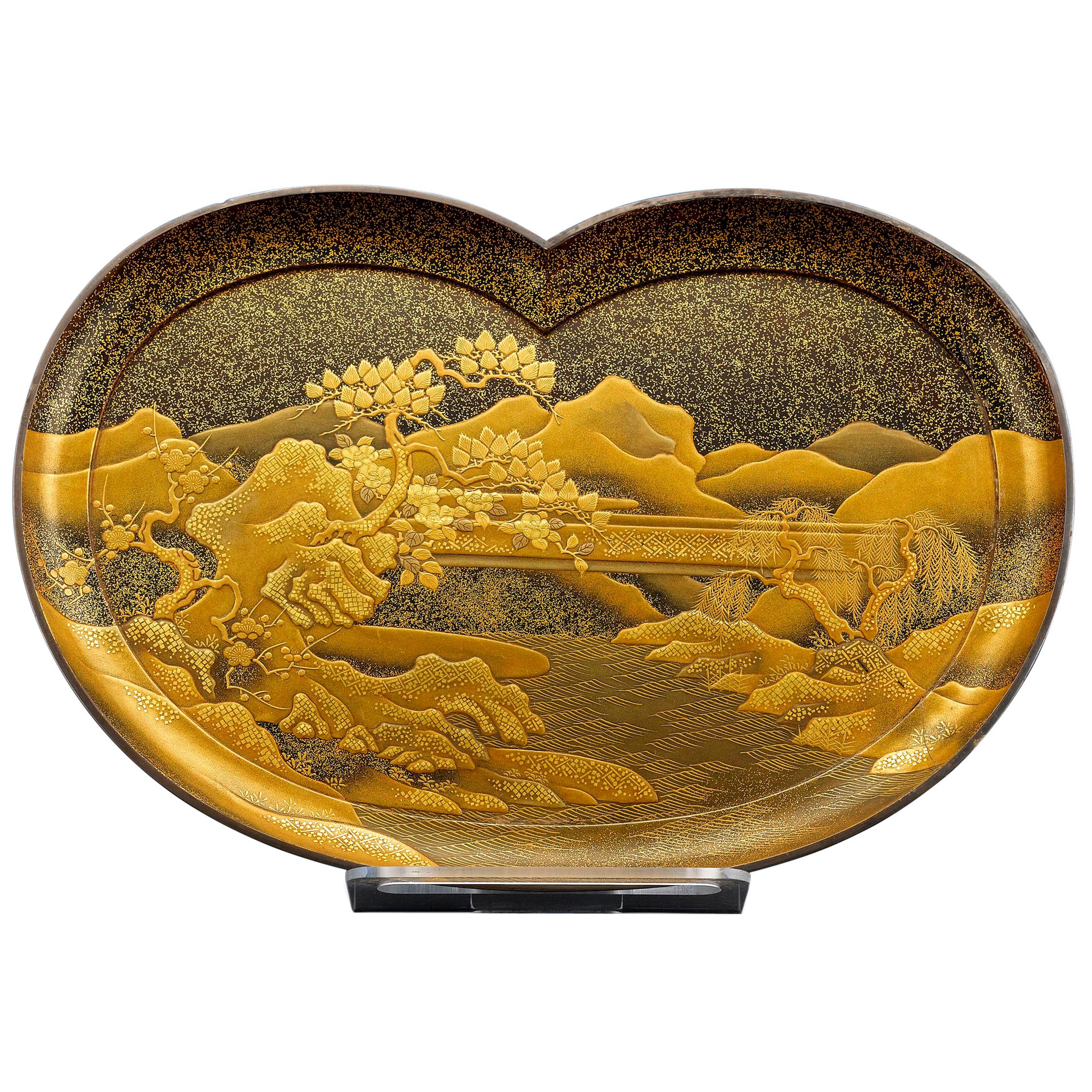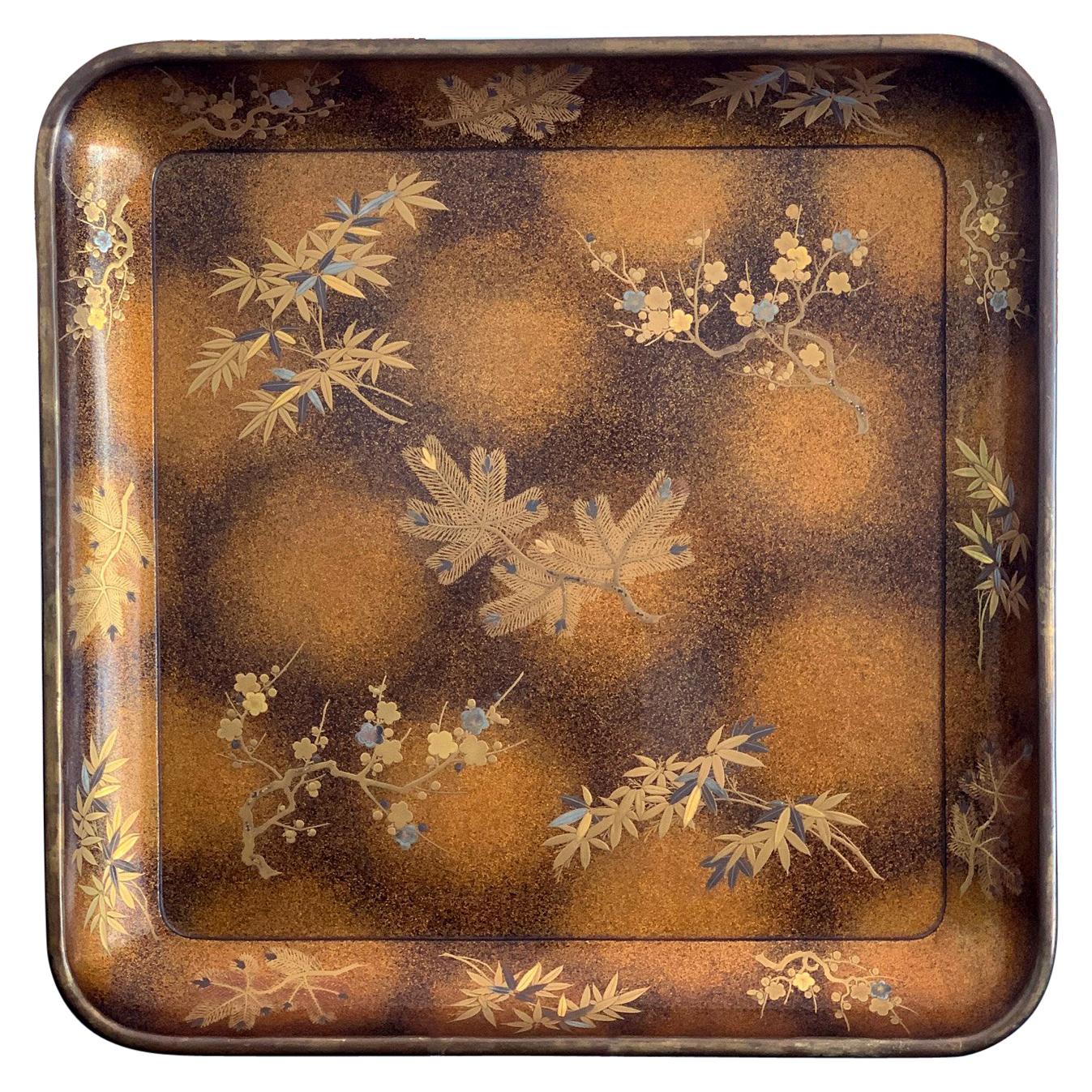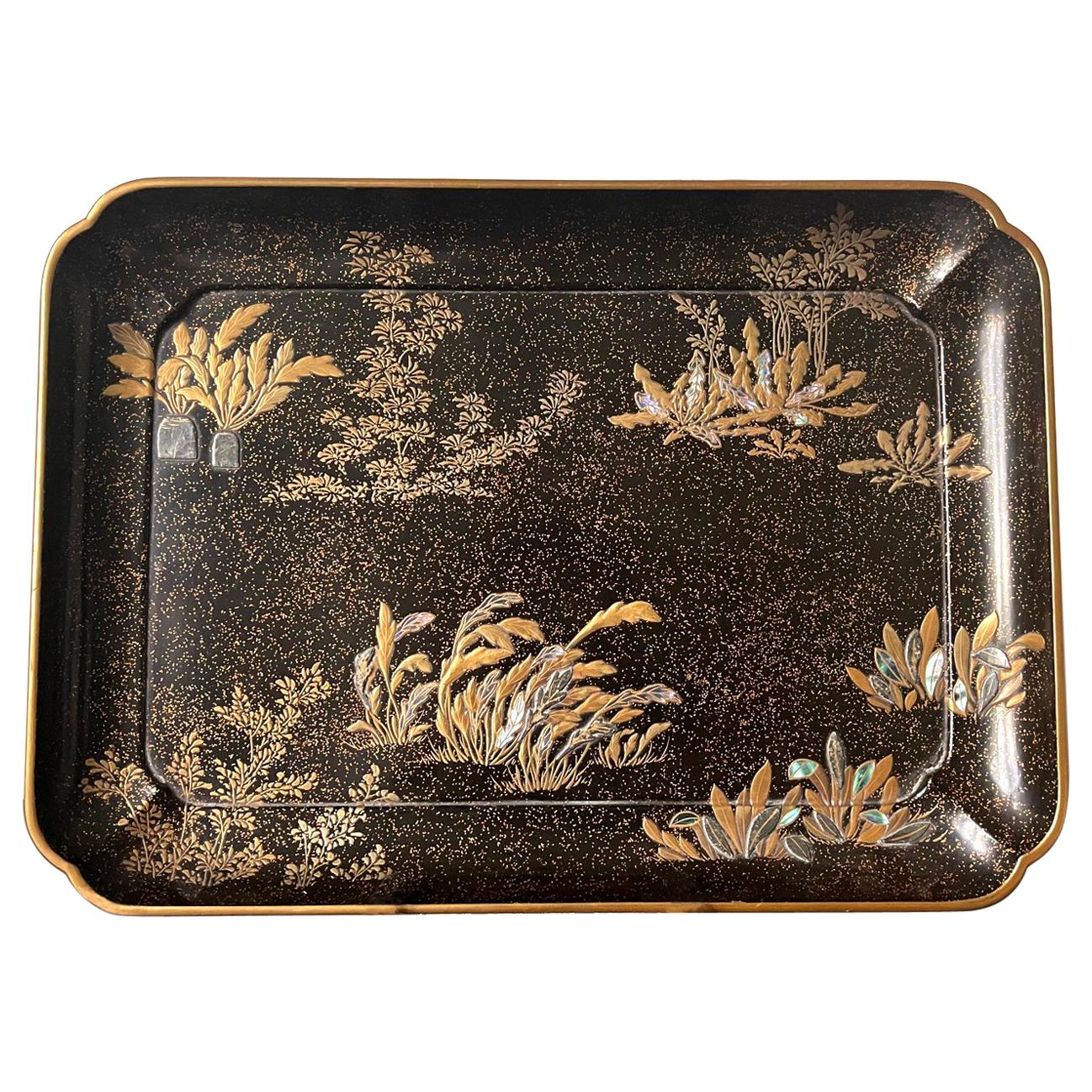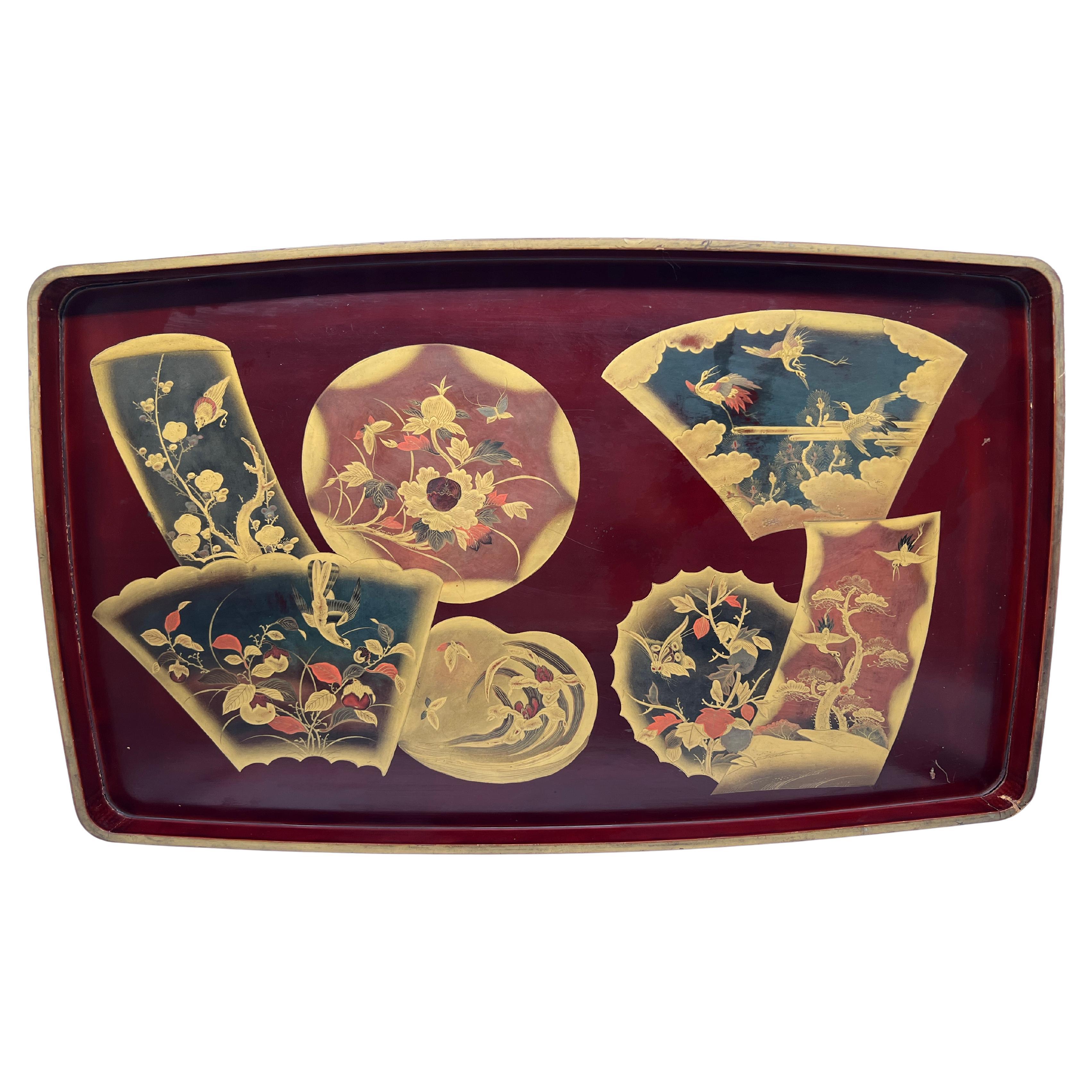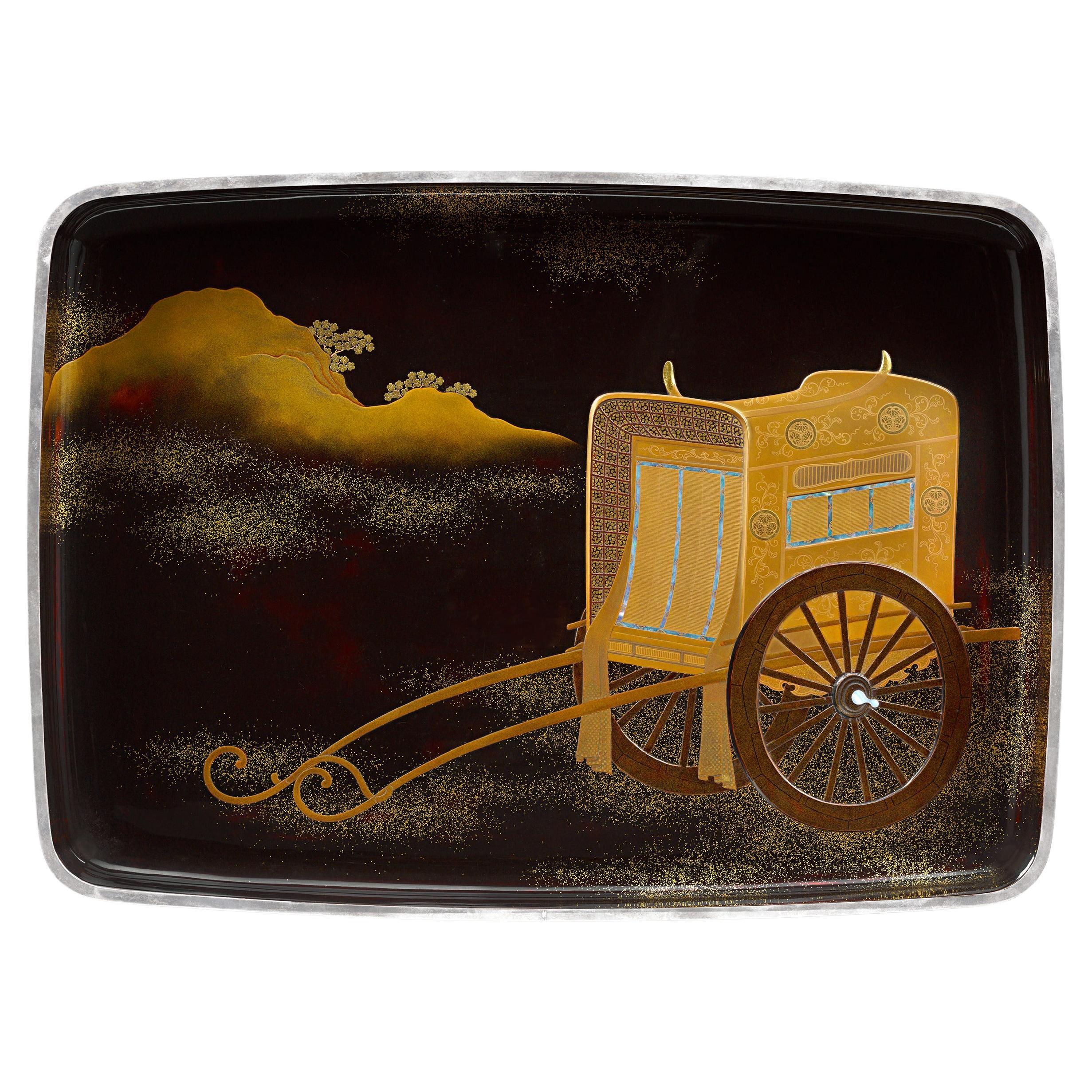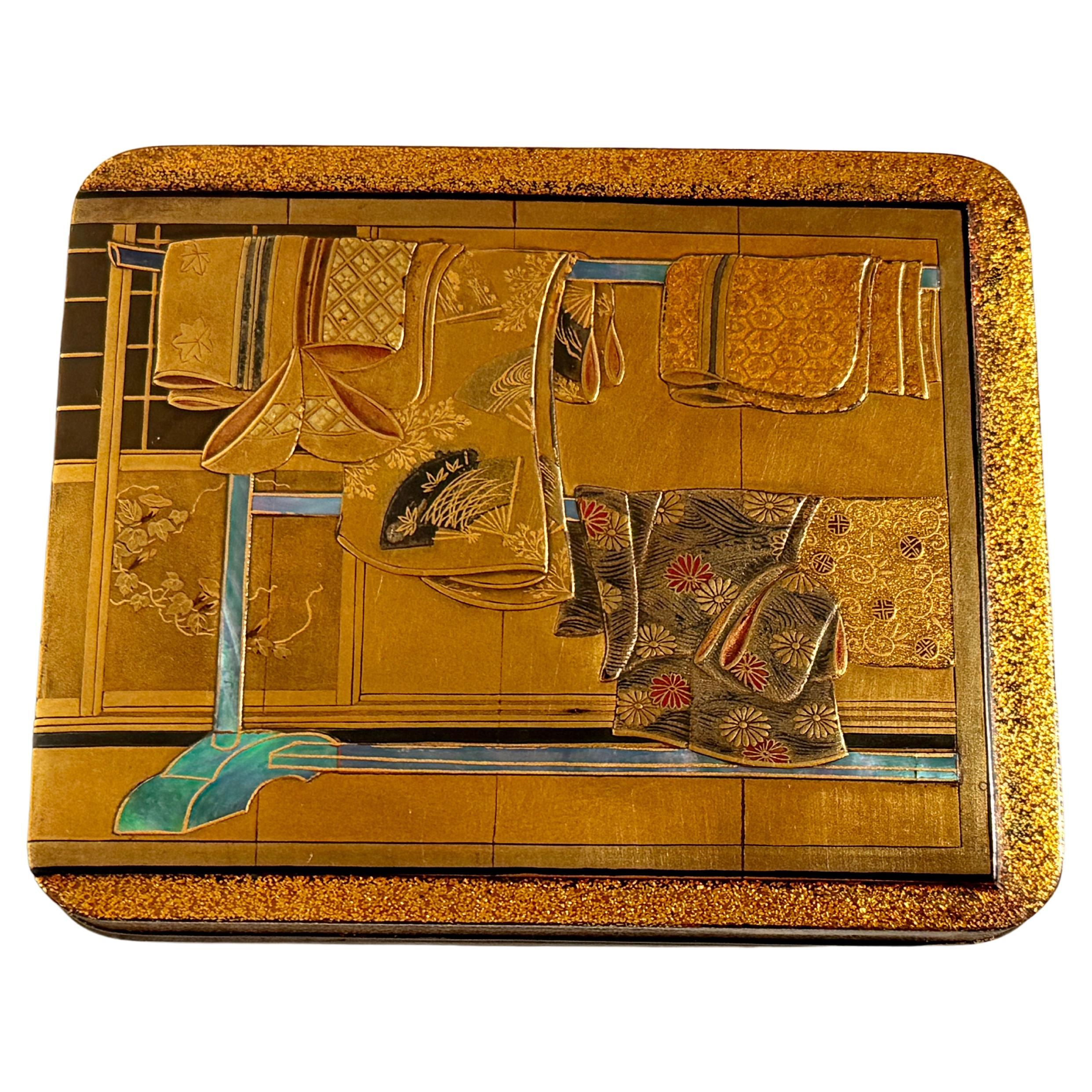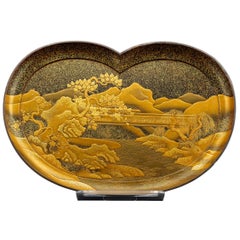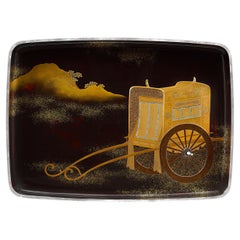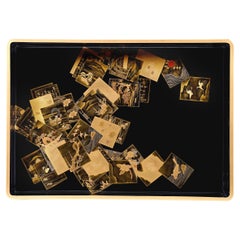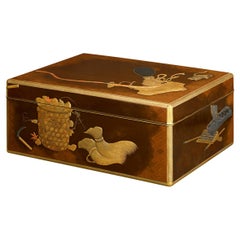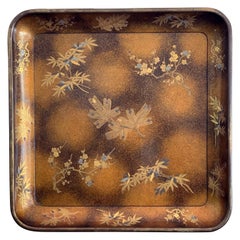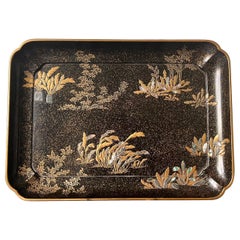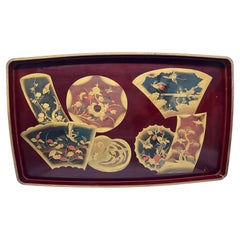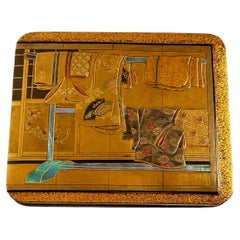Items Similar to Japanese Lacquer and Gold Tray
Want more images or videos?
Request additional images or videos from the seller
1 of 6
Japanese Lacquer and Gold Tray
$16,800
£12,685.82
€14,619.01
CA$23,711.94
A$26,141.88
CHF 13,676.58
MX$320,712.24
NOK 172,161.11
SEK 160,997.86
DKK 109,175.17
About the Item
This Meiji-period lacquer tray represents the mastery of Japanese craftsmen in the art of lacquer work. Precious materials are precisely inlaid in the lacquer base, creating a highly illusionistic three-dimensional effect. Gold lacquer borders the intricately laid design, which features romantic maki-e floral motifs executed in gold and other natural materials. The all-over design highlights the bounty of the natural world.
The creation of a lacquer tray such as this would have been an incredibly time-consuming process; the art form is considered among the most labor intensive in the world and requires an exceptional level of finesse. Intricately detailed lacquer trays such as this reveal the mastery of their maker.
The tray comes set in its original box.
Late 19th century
3 3/4" high x 23 3/4" wide x 23 3/4" high.
- Dimensions:Height: 3.75 in (9.53 cm)Width: 23.75 in (60.33 cm)Depth: 23.75 in (60.33 cm)
- Style:Meiji (Of the Period)
- Materials and Techniques:
- Place of Origin:
- Period:
- Date of Manufacture:Late 19th Century
- Condition:
- Seller Location:New Orleans, LA
- Reference Number:Seller: 31-71321stDibs: LU891134808502
About the Seller
5.0
Recognized Seller
These prestigious sellers are industry leaders and represent the highest echelon for item quality and design.
Established in 1912
1stDibs seller since 2010
111 sales on 1stDibs
Typical response time: 9 hours
- ShippingRetrieving quote...Shipping from: New Orleans, LA
- Return Policy
Authenticity Guarantee
In the unlikely event there’s an issue with an item’s authenticity, contact us within 1 year for a full refund. DetailsMoney-Back Guarantee
If your item is not as described, is damaged in transit, or does not arrive, contact us within 7 days for a full refund. Details24-Hour Cancellation
You have a 24-hour grace period in which to reconsider your purchase, with no questions asked.Vetted Professional Sellers
Our world-class sellers must adhere to strict standards for service and quality, maintaining the integrity of our listings.Price-Match Guarantee
If you find that a seller listed the same item for a lower price elsewhere, we’ll match it.Trusted Global Delivery
Our best-in-class carrier network provides specialized shipping options worldwide, including custom delivery.More From This Seller
View AllJapanese Lacquer Tray
Located in New Orleans, LA
As beautiful as it is practical, this Japanese Meiji-period lacquered tray is distinguished by its exceptional craftsmanship. It exhibits a phenomenal artistry as the entire tray is ...
Category
Early 20th Century Japanese Meiji Lacquer
Materials
Lacquer
$8,850
Japanese Lacquer Tray
Located in New Orleans, LA
Hailing from illustrious Meiji-period Japan, this lacquer tray showcases the mastery of Japanese craftsmen. Precious materials are precisely inlaid in the lacquer base, creating an a...
Category
Antique Late 19th Century Japanese Meiji Lacquer
Materials
Silver
$19,800
Japanese Lacquer Tray With Cards
Located in New Orleans, LA
This Meiji-period lacquer tray represents the mastery of Japanese craftsmen in the art of lacquer work. Precious materials are precisely inlaid in the lacquer base, creating a highly...
Category
Antique Late 19th Century Japanese Meiji Lacquer
Materials
Gold
Japanese Lacquer Box
Located in New Orleans, LA
This exquisite Meiji-period lacquer document box known as a ryoshibako showcases the meticulous artistry of maki-e, a technique of raised lacquer decoration. Adorned with gold and vi...
Category
Antique 19th Century Asian Meiji Lacquer
Materials
Gold
$39,850
Gold Lacquer Incense Box
Located in New Orleans, LA
A Gold Lacquer Kōbako (Incense Box)
Edo Period (1615–1868), Circa 1850
This exquisite gold lacquer kōbako (incense box) exemplifies the refined craftsmans...
Category
Antique 19th Century Japanese Edo Decorative Boxes
Materials
Gold, Silver, Gold Leaf
$9,850
Edo-Period Lacquerware Chest
Located in New Orleans, LA
Edo-Period Lacquerware Chest
19th-century
This exquisite chest, inspired by Hasami-Bako travel trunks, is a striking example of Japanese lacquerware. The hiramaki-e technique—applie...
Category
Antique 19th Century Japanese Edo Decorative Boxes
Materials
Gold
You May Also Like
Large Vintage Japanese Maki-e Lacquer Kimono Tray
Located in Atlanta, GA
A large square lacquer presentation tray (likely for kimono) predated 1950 of the Showa period. Elaborately decorated with Maki-e that depicts the prunus blossom, bamboo and needle p...
Category
Vintage 1940s Japanese Japonisme Lacquer
Materials
Wood, Lacquer
Japanese Lacquer Tray with Maki-e and Inlay Hara Yoyusai Edo Period
Located in Atlanta, GA
A lovely Japanese lacquer rectangular lacquer tray with a slightly scalloped corner and four L shape supporting feet by one of the most celebrated lacquer artist active in Edo period Hara Yoyusai (1772-1845). Yoyusai lived in Edo (Tokyo) and worked under the patronage of Lord Matsudaira. He operated a large workshop and had a very prolific output of lacquer objects. Most survived pieces being inro...
Category
Antique 19th Century Japanese Japonisme Lacquer
Materials
Wood, Lacquer
Antique Large Scale Japanese Lacquer & Gilt Decorated Tray
Located in Atlanta, GA
This exquisite large-scale antique Japanese lacquer tray showcases masterful gilt decoration against a rich lacquered ground. Its expansi...
Category
Antique 19th Century Japanese Anglo-Japanese Lacquer
Materials
Lacquer
$1,036 Sale Price
20% Off
Japanese Tagasode (Whose Sleeves?) Lacquer Incense Box, Kobako, Meiji Period
Located in Austin, TX
A fine and unusual Japanese lacquer box for incense accessories, kobako, featuring a tagasode (whose sleeves?) design, Meiji Period, circa 1900, Japan.
The exquisite box of simple rectangular shape worked in maki-e lacquer, taka-maki-e, and raden, all against a lush ground of gold nashiji. Fitted with silver rims.
The main decorative element of the box depicts a six panel folding screen, byobu, showing an interior scene with kimono strewn over a rack, a motif known as tagasode (whose sleeves), all in raised taka-maki-e lacquer and inlaid raden.
The screen depicts an intimate room with tatami mats on the floor and sliding shoji doors in the background. The foreground depicts a large clothing...
Category
Antique Early 1900s Japanese Meiji Lacquer
Materials
Silver
Japanese Meiji Period Antique Lacquer Box with Gold Maki-e Decoration
Located in New York, NY
A fine antique Japanese Meji Period lacquer box decorated with a fan and a stylized star shaped window in the maki-e technique. The fan at the top right corner, fully opened depictin...
Category
Antique 19th Century Japanese Meiji Lacquer
Materials
Lacquer
French 19th Century Meiji Period Japanese Lacquer And Ormolu Tray; Bointaburet
Located in West Palm Beach, FL
A very unique and highly detailed French 19th century Meiji period Japanese Lacquer and Ormolu Tray, stamped Bointaburet A Paris. This exquisite rectangular tray was fashioned with J...
Category
Antique 19th Century French Centerpieces
Materials
Ormolu
More Ways To Browse
Tray Japan
Japanese Lacquered Tray
Gold Lacquer Tray
Maki E
Meiji Lacquer Box
Antique Japanese Tray
Meiji Japan Tray
Antique Japanese Lacquer Tray
Asian Black And Gold Decoration
Tray Japan
Japanese Lacquered Tray
Maki E
Antique Cinnabar
Japanese Family Crest
Cinnabar Lacquer
Japanese Lacquerware
Japanese Lacquer Pearl
Cinnabar Furniture
